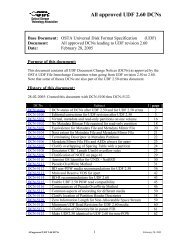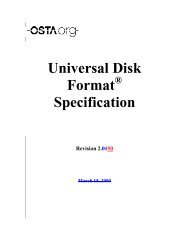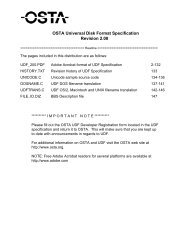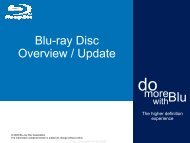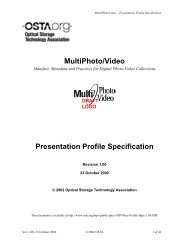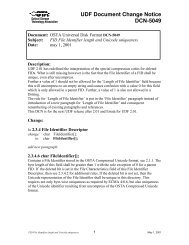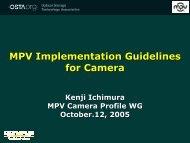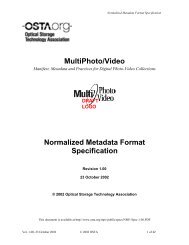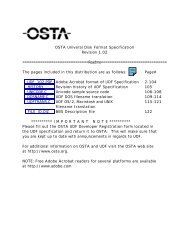osta cd-r compatibility study results from phase 2 - OSTA - Optical ...
osta cd-r compatibility study results from phase 2 - OSTA - Optical ...
osta cd-r compatibility study results from phase 2 - OSTA - Optical ...
You also want an ePaper? Increase the reach of your titles
YUMPU automatically turns print PDFs into web optimized ePapers that Google loves.
CD-R Compatibility Study – Phase 2<br />
the older 1X recorders tended to write discs at considerably higher powers than were<br />
ultimately mandated by the Orange Book. Furthermore, these writers lacked the active<br />
write power control that was recommended in the final specification. This often showed<br />
up as excessively high values of symmetry (or beta) reported by CD testers. Some of the<br />
original CD-R media offerings were tolerant of this overpowering and, in fact, required it<br />
for best <strong>results</strong>. Newer Orange Book Part II (version 2.0) compliant media were designed<br />
to function optimally in the strict, designated write power range and encountered<br />
understandable performance degradation when written in overpowered, non-standard<br />
conditions. All newer writers, including 2X, 4X, and 6X offerings, have sophisticated<br />
write power selection and control capabilities and generate considerably higher quality<br />
discs than do the older 1X devices. This result has been extensively corroborated by a<br />
number of other comprehensive studies.<br />
When the Orange Book was finalized, most, if not all, of the original manufacturers of<br />
non-standard writers modified their devices to conform to the final requirements.<br />
However, there still is a remnant installed population, albeit minuscule, of the older, nonstandard<br />
writers in use. Some of these can be upgraded to be in compliance with the<br />
Orange Book (usually by the manufacturer for a moderate price) but this information is<br />
not always widely publicized or known. It is quite possible that no problems are<br />
encountered when reading with these devices, but when using newer, multi-speed capable<br />
media types, users may encounter what appear to be “<strong>compatibility</strong>” problems due to the<br />
violation of Orange Book writing guidelines.<br />
The current release of the Orange Book (Part II: CD-R, Version 3.0, December 1997)<br />
continues to refine the relationship between CD-R media and CD recorder writing<br />
functions. The defined recording speeds now include 1X, 2X and 4X nominal CD speed.<br />
Improved definitions have been established for CD-R media to implement optimum<br />
writing power controls between the recorder and the media. Likewise special information<br />
can be coded into blank CD-R media to identify its disc type and the starting or indicative<br />
optimum writing power.<br />
Future improvements to CD-R media and recording systems can be expected due to the<br />
ongoing work of Philips and Sony as they further refine Orange Book specifications.<br />
Likewise the Orange Forum (formerly known as OSJ, the Orange Book Study Group of<br />
Japan) continues its work to support Philips and Sony by addressing CD-R market<br />
introduction issues.<br />
Today, concerns regarding <strong>compatibility</strong> are greatly diminished due to major advances in<br />
the quality and robustness of writers, media, and readers. Like all recordable technologies,<br />
some problems are still encountered with CD-R. However, in almost all instances, these<br />
can be attributed to systems conflicts, software deficiencies, or the occasional<br />
malfunctioning writer or reader.<br />
2 © <strong>OSTA</strong> – <strong>Optical</strong> Storage Technology Association



